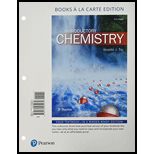
Introductory Chemistry, Books a la Carte Plus Mastering Chemistry with Pearson eText -- Access Card Package (6th Edition)
6th Edition
ISBN: 9780134557311
Author: Nivaldo J. Tro
Publisher: PEARSON
expand_more
expand_more
format_list_bulleted
Concept explainers
Textbook Question
Chapter 3, Problem 118E
Global warming refers to the rise in average global temperature due to the increased concentration of certain gases, called greenhouse gases, in our atmosphere. Earth’s oceans, because of their high heat capacity, absorb heat and therefore act to slow down global warming. How much heat would be required to warm Earth’s oceans by 1.0 ∘C
? Assume that the volume of water in Earth’s oceans is 137×107 km3 and that the density of seawater is 1.03 g /cm3. Also assume that the heat capacity of seawater is the same as that of water.

Earth’s oceans moderate temperature by absorbing heat during warm perioda.
Expert Solution & Answer
Want to see the full answer?
Check out a sample textbook solution
Students have asked these similar questions
pls help asap on all.
pls help asap on all.
pls help asap on all.
Chapter 3 Solutions
Introductory Chemistry, Books a la Carte Plus Mastering Chemistry with Pearson eText -- Access Card Package (6th Edition)
Ch. 3 - Which substance is a pure compound? a. Gold b....Ch. 3 - Which property of trinitrotoluene (TNT) is most...Ch. 3 - Which change is a chemical change? a. The...Ch. 3 - Q4. Which process is endothermic?
a. The burning...Ch. 3 - Q5. A 35-g sample of potassium completely reacts...Ch. 3 - Prob. 6SAQCh. 3 - Convert the boiling point of water (100.00C) to K....Ch. 3 - Q8. A European doctor reports that you have fever...Ch. 3 - Q9. How much heat must be absorbed by 125 g of...Ch. 3 - Q10. Substance A has a heat capacity that is much...
Ch. 3 - Define matter and list some examples.Ch. 3 - Prob. 2ECh. 3 - What are the three states of matter?Ch. 3 - Prob. 4ECh. 3 - Prob. 5ECh. 3 - Prob. 6ECh. 3 - Prob. 7ECh. 3 - Prob. 8ECh. 3 - 9. What is a mixture?
Ch. 3 - 10. What is the difference between a homogeneous...Ch. 3 - What is a pure substance?Ch. 3 - What is an element? A compound?Ch. 3 - What is the difference between a mixture and a...Ch. 3 - Prob. 14ECh. 3 - 15. What is the difference between a physical...Ch. 3 - Prob. 16ECh. 3 - Prob. 17ECh. 3 - Prob. 18ECh. 3 - Prob. 19ECh. 3 - What is chemical energy? List some examples of...Ch. 3 - Prob. 21ECh. 3 - 22. What is an exothermic reaction? Which has...Ch. 3 - 23. What is an endothermic reaction? Which has...Ch. 3 - Prob. 24ECh. 3 - Prob. 25ECh. 3 - 26. How do the three temperature scales differ?
Ch. 3 - Prob. 27ECh. 3 - Prob. 28ECh. 3 - The following equation can be used to convert...Ch. 3 - Prob. 30ECh. 3 - Classify each pure substance as an element or a...Ch. 3 - 32. Classify each pure substance as an element or...Ch. 3 - 33. Classify each mixture as homogeneous or...Ch. 3 - 34. Classify each mixture as homogeneous or...Ch. 3 - 35. Classify each substance as a pure substance or...Ch. 3 - 36. Classify each substance as a pure substance or...Ch. 3 - Classify each property as physical or chemical. a....Ch. 3 - Classify each property as physical or chemical. a....Ch. 3 - Which of the following properties of ethylene(a...Ch. 3 - Which of the following properties of ozone (a...Ch. 3 - 41. Classify each change as physical or...Ch. 3 - 42. Classify each change as physical or...Ch. 3 - A block of aluminum is (a) ground into aluminum...Ch. 3 - 44. Several pieces of graphite from a mechanical...Ch. 3 - 45. An automobile gasoline tank holds 42 kg of...Ch. 3 - In the explosion of a hydrogen-filled balloon,...Ch. 3 - 47. Are these data sets on chemical changes...Ch. 3 - 48. Are these data sets on chemical changes...Ch. 3 - Prob. 49ECh. 3 - 50. A 56-g sample of iron reacts with 24 g of...Ch. 3 - Prob. 51ECh. 3 - Prob. 52ECh. 3 - Prob. 53ECh. 3 - Prob. 54ECh. 3 - Prob. 55ECh. 3 - Prob. 56ECh. 3 - Prob. 57ECh. 3 - Prob. 58ECh. 3 - Prob. 59ECh. 3 - Prob. 60ECh. 3 - 61 A common type of handwarmer contains Iron...Ch. 3 - 62. In a chemical cold pack, two substances are...Ch. 3 - 63. Classify each process as exothermic or...Ch. 3 - Classify each process as exothermic or...Ch. 3 - Perform each temperature conversion. a.212 F to...Ch. 3 - Prob. 66ECh. 3 - The coldest temperature ever measured in the...Ch. 3 - 68. The warmest temperature ever measured in the...Ch. 3 - 69. Vodka does not freeze in the freezer because...Ch. 3 - Liquid helium boils at 4.2 K. Convert this...Ch. 3 - 71. The temperature in the South Pole during the...Ch. 3 - Prob. 72ECh. 3 - Prob. 73ECh. 3 - Prob. 74ECh. 3 - 75. Calculate the amount of heat required to raise...Ch. 3 - 76. Calculate the amount of heat required to raise...Ch. 3 - Calculate the amount of heat required to heat a...Ch. 3 - 78. Calculate the amount of heat required to heat...Ch. 3 - If 89 J of heat are added to a pure gold coin with...Ch. 3 - If 57 J heat are added to an aluminum can with a...Ch. 3 - An iron nail with a mass of 12 g absorbs 15 J of...Ch. 3 - Prob. 82ECh. 3 - Prob. 83ECh. 3 - 84. A lead fishing weight with a mass of 57 g...Ch. 3 - An unknown metal with a mass of 28 g absorbs 58 J...Ch. 3 - When 2.8 J of heat are added to 5.6 g of an...Ch. 3 - When 56 J of heat are added to 11 g of a liquid,...Ch. 3 - Prob. 88ECh. 3 - Prob. 89ECh. 3 - Prob. 90ECh. 3 - How much energy (In J) lost when a sample of iron...Ch. 3 - Prob. 92ECh. 3 - Prob. 93ECh. 3 - Prob. 94ECh. 3 - A pure gold ring with a volume of 1.57 cm3 is...Ch. 3 - Prob. 96ECh. 3 - Prob. 97ECh. 3 - Prob. 98ECh. 3 - 99. What is the temperature change (ΔT) in Celsius...Ch. 3 - Prob. 100ECh. 3 - Prob. 101ECh. 3 - Prob. 102ECh. 3 - A backpacker wants to carry enough fuel to heat...Ch. 3 - 104. A cook wants to heat 1.35 kg of water from...Ch. 3 - Evaporating sweat cools the body because...Ch. 3 - Prob. 106ECh. 3 - A 15.7-g aluminum block is warmed to 53.2C and...Ch. 3 - A 25.0-mL sample of ethanol (density = 0.789g/mL)...Ch. 3 - The wattage of an appliance indicates its average...Ch. 3 - Prob. 110ECh. 3 - What temperature is the same whether it is...Ch. 3 - What temperature on the Celsius scale is equal to...Ch. 3 - 113. Classify each as pure substance or a...Ch. 3 - Classify each as a pure substance or a mixture. If...Ch. 3 - This molecular drawing shows images of acetone...Ch. 3 - This molecular drawing shows of methane molecules...Ch. 3 - Prob. 117ECh. 3 - Global warming refers to the rise in average...Ch. 3 - 119. Examine the data for the maximum and minimum...Ch. 3 - Using white and black circles to represent...Ch. 3 - Prob. 121QGWCh. 3 - 122. A friend asks you to invest in a new...Ch. 3 - Prob. 123QGW
Knowledge Booster
Learn more about
Need a deep-dive on the concept behind this application? Look no further. Learn more about this topic, chemistry and related others by exploring similar questions and additional content below.Similar questions
- 18. A 10.2g piece of coal (carbon) is combusted completely beneath a calorimeter containing 800.0 mL of water. The initial temp of the water was 20.0°C, and the final temp was 62.7°C. Assuming complete transfer of heat from the carbon to the water, what is the molar enthalpy of combustion of carbon?arrow_forwardpls help asap on all.arrow_forwardpls help asap on all.arrow_forward
- Use the reaction coordinate graph below to answer questions 13-15: 13. Which step is the rate determining step? a. C→ E b. E→ G C. A → C d. Not enough information 14. The overall reaction: a. is exothermic b. is endothermic C. has no change in energy Energy d. not enough information 15. The activation energy for the overall reaction would be equal to: a. Ꭰ A b. F C. B d. B + D + F B 0 D E Reaction coordinate Garrow_forwardpls help asap on all.arrow_forwardpls help asap on all.arrow_forward
- 3. Which of the following best describes the changes in reaction rate for the reactants as a reaction progresses? a. Reaction rate remains relatively constant for the duration of the reaction b. Reaction rate is highest at the beginning, and decreases over time C. Reaction rate is highest at the beginning and end of a reaction d. Reaction rate is slow at first, then increases 4. Which of these would be the closest to being an isolated system? a. A well-insulated steel thermos b. Earth C. A sealed plastic container d. All of the above are examples 5. A chemical engineer is performing a test to see if a proposed catalyst for an industrial chemical reaction is working effectively. Which of the following would be positive evidence that it's working? a. The enthalpy of the reaction increases b. Less heat is required to get the reaction started C. The reaction creates new products d. The enthalpy of the reaction decreasesarrow_forwardPls help me on this q.arrow_forwardGiven the elementary reactions in an aqueous medium with an ionic strength of 0.001:1) CH3Br + OH- → CH3OH + Br-2) ClCH2COO- + OH- → HOCH2COO- + Cl-3) [Co(NH3)5Br]2+ + NO2- →[Co(NH3)5NO2]2+ + Br-If the ionic strength is decreased, 1) k will not change; 2) k will decrease; and 3) k will increase. Is this correct?arrow_forward
- Relate zero ionic strength and infinite dilution limit.arrow_forwardThe photolysis of H3C–N=N–C2H5 involves the breaking of the single bonds shown. According to this, in addition to N2, what products would be obtained primarily if the reaction were carried out in the gas phase or in solution in an inert solvent?arrow_forwardGiven a keto-enol tautomerization reaction, which is greatly influenced by the type of solvent, indicate which of the following solvent properties cannot be considered a "solvent effect"?(A) Dielectric constant(B) Polarity(C) Hydrogen bonding capacity(D) Temperaturearrow_forward
arrow_back_ios
SEE MORE QUESTIONS
arrow_forward_ios
Recommended textbooks for you
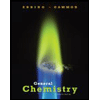 General Chemistry - Standalone book (MindTap Cour...ChemistryISBN:9781305580343Author:Steven D. Gammon, Ebbing, Darrell Ebbing, Steven D., Darrell; Gammon, Darrell Ebbing; Steven D. Gammon, Darrell D.; Gammon, Ebbing; Steven D. Gammon; DarrellPublisher:Cengage Learning
General Chemistry - Standalone book (MindTap Cour...ChemistryISBN:9781305580343Author:Steven D. Gammon, Ebbing, Darrell Ebbing, Steven D., Darrell; Gammon, Darrell Ebbing; Steven D. Gammon, Darrell D.; Gammon, Ebbing; Steven D. Gammon; DarrellPublisher:Cengage Learning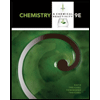 Chemistry & Chemical ReactivityChemistryISBN:9781133949640Author:John C. Kotz, Paul M. Treichel, John Townsend, David TreichelPublisher:Cengage Learning
Chemistry & Chemical ReactivityChemistryISBN:9781133949640Author:John C. Kotz, Paul M. Treichel, John Townsend, David TreichelPublisher:Cengage Learning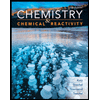 Chemistry & Chemical ReactivityChemistryISBN:9781337399074Author:John C. Kotz, Paul M. Treichel, John Townsend, David TreichelPublisher:Cengage Learning
Chemistry & Chemical ReactivityChemistryISBN:9781337399074Author:John C. Kotz, Paul M. Treichel, John Townsend, David TreichelPublisher:Cengage Learning ChemistryChemistryISBN:9781305957404Author:Steven S. Zumdahl, Susan A. Zumdahl, Donald J. DeCostePublisher:Cengage Learning
ChemistryChemistryISBN:9781305957404Author:Steven S. Zumdahl, Susan A. Zumdahl, Donald J. DeCostePublisher:Cengage Learning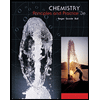 Chemistry: Principles and PracticeChemistryISBN:9780534420123Author:Daniel L. Reger, Scott R. Goode, David W. Ball, Edward MercerPublisher:Cengage Learning
Chemistry: Principles and PracticeChemistryISBN:9780534420123Author:Daniel L. Reger, Scott R. Goode, David W. Ball, Edward MercerPublisher:Cengage Learning Chemistry: Principles and ReactionsChemistryISBN:9781305079373Author:William L. Masterton, Cecile N. HurleyPublisher:Cengage Learning
Chemistry: Principles and ReactionsChemistryISBN:9781305079373Author:William L. Masterton, Cecile N. HurleyPublisher:Cengage Learning

General Chemistry - Standalone book (MindTap Cour...
Chemistry
ISBN:9781305580343
Author:Steven D. Gammon, Ebbing, Darrell Ebbing, Steven D., Darrell; Gammon, Darrell Ebbing; Steven D. Gammon, Darrell D.; Gammon, Ebbing; Steven D. Gammon; Darrell
Publisher:Cengage Learning

Chemistry & Chemical Reactivity
Chemistry
ISBN:9781133949640
Author:John C. Kotz, Paul M. Treichel, John Townsend, David Treichel
Publisher:Cengage Learning

Chemistry & Chemical Reactivity
Chemistry
ISBN:9781337399074
Author:John C. Kotz, Paul M. Treichel, John Townsend, David Treichel
Publisher:Cengage Learning

Chemistry
Chemistry
ISBN:9781305957404
Author:Steven S. Zumdahl, Susan A. Zumdahl, Donald J. DeCoste
Publisher:Cengage Learning

Chemistry: Principles and Practice
Chemistry
ISBN:9780534420123
Author:Daniel L. Reger, Scott R. Goode, David W. Ball, Edward Mercer
Publisher:Cengage Learning

Chemistry: Principles and Reactions
Chemistry
ISBN:9781305079373
Author:William L. Masterton, Cecile N. Hurley
Publisher:Cengage Learning
Calorimetry Concept, Examples and Thermochemistry | How to Pass Chemistry; Author: Melissa Maribel;https://www.youtube.com/watch?v=nSh29lUGj00;License: Standard YouTube License, CC-BY